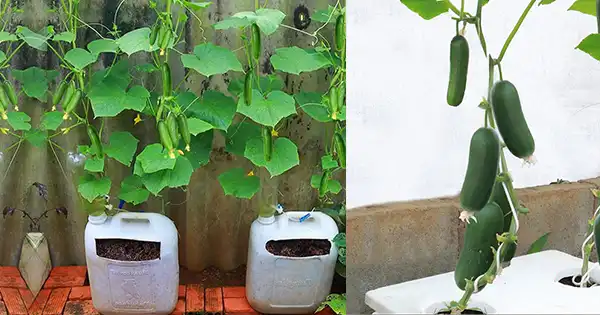Growing baby cucumbers at home in containers is a rewarding and enjoyable gardening experience. Whether you have limited outdoor space or simply want to bring the joys of gardening indoors, container gardening offers a convenient and productive way to cultivate these crisp and refreshing vegetables. In this guide, we’ll walk you through the step-by-step process of cultivating baby cucumbers in containers, from selecting the right container to caring for your plants as they flourish.
Choosing the Right Container:
- Size Matters: Opt for containers that are at least 12 inches deep and 12 inches wide to provide enough space for cucumber roots to grow.
- Drainage is Key: Ensure your container has adequate drainage holes to prevent waterlogging and root rot.
- Material: Choose containers made of materials like plastic, ceramic, or fabric. Each material has its advantages in terms of water retention and insulation.
Selecting Cucumber Varieties:
- Bush Varieties: Look for compact or bush cucumber varieties suited for container gardening. These varieties take up less space and are better suited for smaller environments.
- Dwarf Varieties: Some cucumber cultivars are specifically bred for container gardening. These “dwarf” varieties are ideal for limited spaces.
Planting Process:
- Quality Soil: Use well-draining, nutrient-rich potting mix to ensure healthy growth.
- Sowing Seeds: Plant cucumber seeds about 1 inch deep in the soil, following the spacing recommendations on the seed packet.
- Germination: Keep the soil consistently moist to aid germination, using a spray bottle to avoid disturbing the seeds.
- Thinning: Once seedlings have sprouted and developed a couple of true leaves, thin them to one or two strong seedlings per container.
Container Care:
- Sunlight: Place containers in a location that receives at least 6-8 hours of direct sunlight daily.
- Watering: Keep the soil consistently moist, not soggy. Water at the base of the plant to avoid wetting the leaves, which can lead to fungal issues.
- Support: As the cucumber plants grow, provide them with a trellis or stakes for support to encourage upward growth and save space.
- Fertilization: Feed your plants with a balanced liquid fertilizer every two to three weeks to ensure healthy growth and fruit production.
Pest and Disease Management:
- Inspect Regularly: Check plants for signs of pests like aphids, cucumber beetles, or spider mites. Also, watch for diseases like powdery mildew.
- Natural Remedies: Introduce beneficial insects like ladybugs, or use neem oil or insecticidal soap to manage pests.
- Pruning: Remove affected leaves and stems promptly to prevent the spread of diseases.
Harvesting Baby Cucumbers:
- Timing: Baby cucumbers are typically ready for harvest within 50 to 60 days from planting.
- Size: Harvest cucumbers when they are about 4-6 inches long for optimal tenderness and flavor.
- Regular Harvesting: Regularly pick mature cucumbers to encourage the plant to produce more fruit.
Conclusion: Cultivating baby cucumbers at home in containers is a fantastic way to enjoy the pleasures of gardening, even with limited space. By choosing the right container, providing the right care, and monitoring for pests and diseases, you can successfully grow these refreshing vegetables right on your doorstep. With a little effort and a lot of enthusiasm, you’ll be enjoying your homegrown baby cucumbers in no time. Happy gardening!
